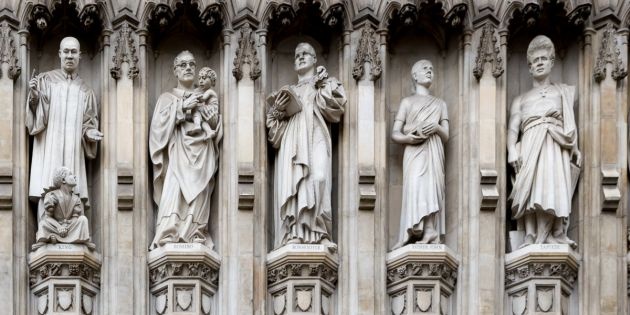1945
The execution of Dietrich Bonhoeffer
Over the west door of Westminster Abbey is a series of ten sculptures: the Gallery of 20th Century Martyrs. They include Maximilian Kolbe, the Polish priest who gave his life to save a fellow prisoner in Auschwitz; Manche Masemola, a young South African girl murdered by her parents for converting to Christianity; Janani Luwum, the Ugandan Archbishop, assassinated on the orders of Idi Amin; Grand Duchess Elizabeth of Russia, killed by the Bolsheviks; Martin Luther King, Jr.; Archbishop Oscar Romero; Esther John, a Pakistani nurse knifed to death for converting from Islam; Lucian Tapiedi, a New Guinea Anglican murdered by Japanese troops in World War II; and Wang Zhiming, a Chinese evangelist killed during the Cultural Revolution. In the middle of these statues stands one depicting Dietrich Bonhoeffer.
Dietrich Bonhoeffer (1906-1945) was a German Protestant clergyman and theologian. He studied in Berlin and New York, receiving two doctorates before his ordination in 1931. He was teaching systematic theology at the University of Berlin when the Nazis came to power in 1933. Bonhoeffer revealed himself as a bold opponent of National Socialism and Adolf Hitler. He attacked the Führer on the radio and helped to establish the Confessing Church, an underground movement to counteract the official Nazi-oriented Church. The Nazis arrested his colleague Martin Niemoller, persecuted the Confessing Church and banned Bonhoeffer from living in the capital. For a time, he pastored in German-speaking churches in London and then ran clandestine ministerial training efforts back in Germany. When the war broke out he was studying in New York City. Friends congratulated him on being in a safe haven but the author of The Cost of Discipleship thought differently, saying: “Christians in Germany will have to face the terrible alternative of either willing the defeat of their nation in order that Christian civilization may survive or willing the victory of their nation and thereby destroying civilization. I know which of these alternatives I must choose but I cannot make that choice from security.” He returned to his homeland where he continued to be harassed by the authorities.
Hitler’s control of the German military was not a complete one; pockets of opposition to him lingered among the army, particularly among Christian officers. One such circle arranged for him to join the Abwehr, the army intelligence branch. As an agent he carried out secret anti-Nazi activities, helped German Jews escape and made contact with voices in the Allied countries. In 1943 he, his brother Klaus and his brother-in-law Hans von Donhanyi were arrested. Along with other plotters he was executed in the final weeks of the war.
“When Christ calls a man, he bids him come and die.”
